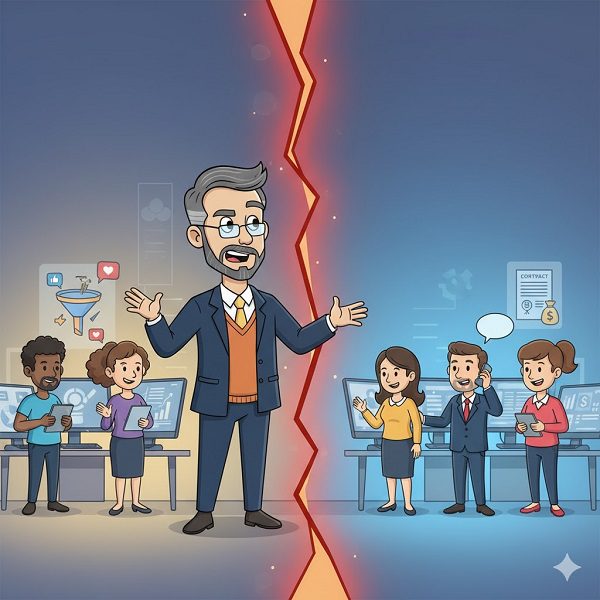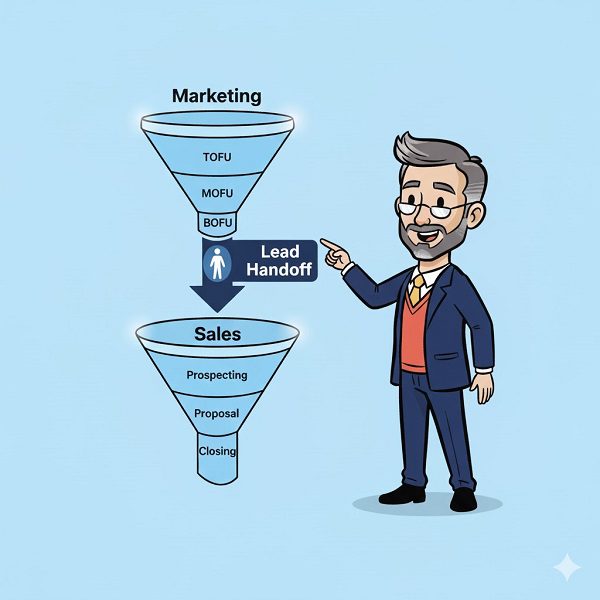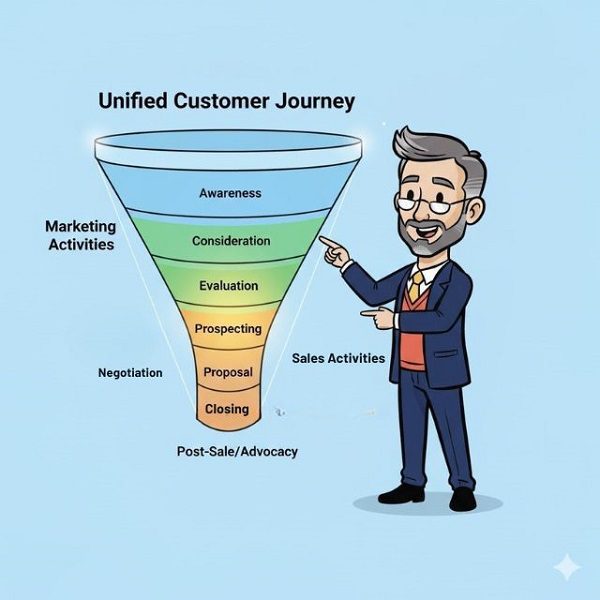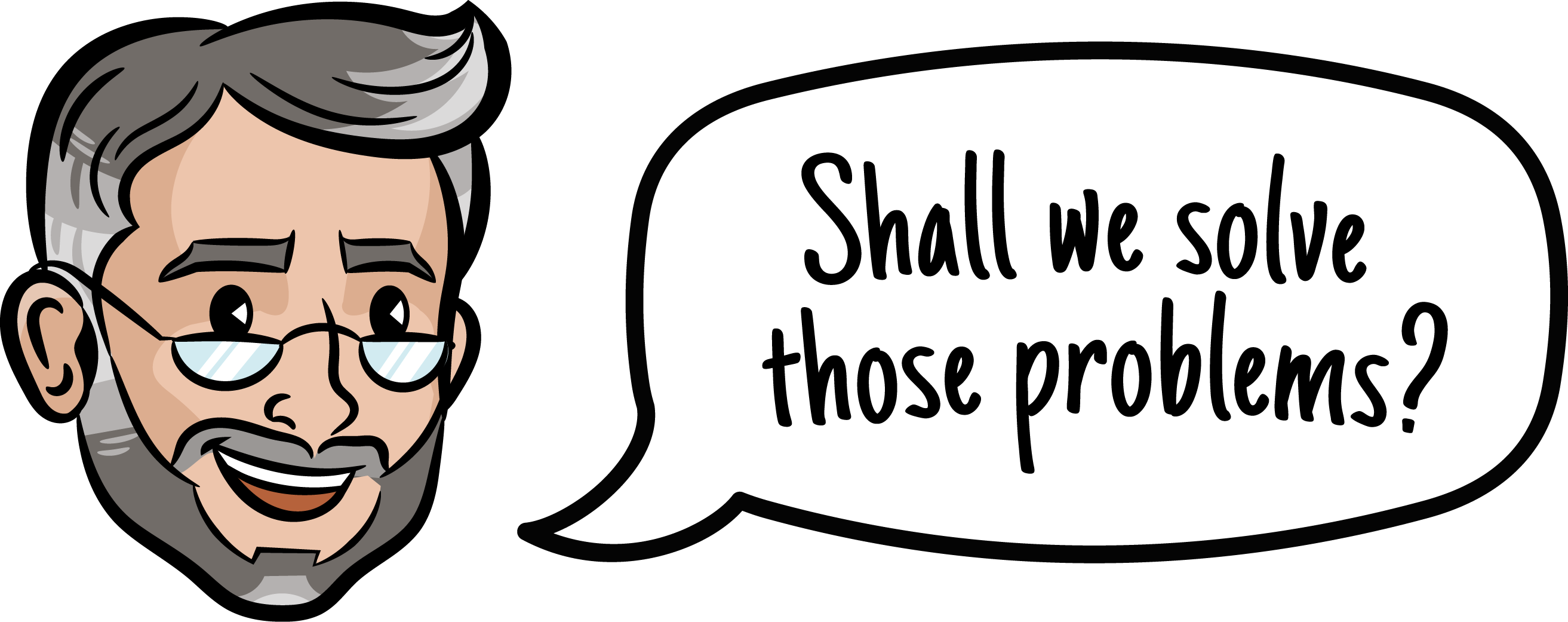Table of Contents
Difference Between a Marketing Funnel vs Sales Funnel
Understanding the Sales Funnel vs. Marketing Funnel: A Foundation for Growth
What is the Marketing Funnel? Definition and Stages
What is the Sales Funnel? Definition and Stages
Key Differences and Critical Overlaps
The Imperative of Sales-Marketing Alignment
Strategies for Achieving Sales-Marketing Alignment
The Unified Funnel: A Seamless Customer Journey (Full Funnel Strategy)
Measuring the Success of Alignment
Conclusion: Driving Revenue Through Collaboration
Useful Related Posts from Sales Funnel Professor
Difference Between a Marketing Funnel vs Sales Funnel
As marketing and sales leaders, we’ve all been there. Marketing works tirelessly to generate leads, pouring effort into campaigns and content. Sales eagerly await the handoff, ready to close deals. Yet, somehow, leads seem to fall through the cracks, sales question the quality of what marketing provides, and a quiet (or not-so-quiet) friction exists between two teams ostensibly working towards the same goal: driving revenue. Sound familiar?
This disconnect often stems from a fundamental misunderstanding – or perhaps, an over-simplification – of the relationship between the marketing funnel and the sales funnel. Too often, these are viewed as distinct, siloed processes. In reality, they are interconnected parts of a larger, seamless customer journey. Understanding this relationship is the first step. The crucial next step is achieving sales marketing alignment to ensure leads move smoothly from initial interest to becoming loyal customers.
In this article, we’ll delve into the specifics of the marketing funnel and the sales funnel, highlighting their unique roles and critical overlap. More importantly, we’ll explore why sales marketing alignment is not just a nice-to-have, but an imperative for modern business growth, addressing common pain points like lead handoff process friction and perceived lead quality issues head-on. By adopting a full funnel strategy perspective, leaders can bridge the gap, accelerate conversion rates, and unlock significant revenue potential.

Understanding the Sales Funnel vs. Marketing Funnel: A Foundation for Growth
The common challenge for many organizations is a perceived chasm between marketing and sales. Marketing focuses on the top-of-funnel activities – building brand awareness, attracting visitors, and generating leads. Sales focuses on the bottom-of-funnel activities – qualifying prospects, closing deals, and driving immediate revenue. While their activities differ, their ultimate objective is shared: sustainable business growth fueled by customer acquisition and retention. The results of this misalignment are felt directly by the customer, with studies showing that 81% of B2B buyers find the buying process unsatisfactory.
Think of the journey a potential customer takes from hearing about your company for the first time to becoming a paying customer. This journey isn’t a series of isolated events; it’s a continuum. The traditional marketing funnel and sales funnel are simply models we use to understand and manage different phases of this continuum. Seeing them as interconnected parts of a larger customer journey, rather than separate entities, is foundational to achieving strategic alignment.
This article aims to clearly define the differences and identify the overlaps between these two vital models. Our core focus, however, is on the absolute necessity of aligning them. For marketing and sales leaders wrestling with issues like inconsistent lead quality, slow lead handoff process, or internal departmental friction, understanding this alignment is the key to unlocking more efficient processes, faster conversions, and ultimately, greater revenue growth.
What is the Marketing Funnel? Definition and Stages
From a marketing perspective, the marketing funnel is a model that illustrates the journey of a potential customer from initial awareness of a brand or product to expressing enough interest to become a lead. Its primary goal is to attract a broad audience and nurture their interest, educating them and building trust until they are ready for a more direct engagement, typically with the sales team.
The marketing funnel is fundamentally about lead generation and initial lead nurturing. Marketing activities at each stage are designed to engage potential customers based on their level of awareness and interest. This content-driven approach is critical because 55% of B2B marketers report that content marketing is effective in building relationships with customers—the essential goal of the nurturing stage.
Common Stages of the Marketing Funnel:
The marketing funnel is typically divided into three main stages, mirroring the customer’s progression:
- Awareness (Top of Funnel – TOFU)
- This is the widest part of the funnel, where the goal is to attract a large audience and make them aware of your brand, products, or services. Potential customers may not even be actively looking for a solution yet, but they are experiencing a problem or have a need that your offering could potentially address.
- Activities at this stage focus on casting a wide net and providing value through educational or entertaining content. This includes:
- Content marketing: Blog posts, articles, infographics, videos addressing common questions or industry trends.
- SEO: Optimizing content and website for search engines to attract organic traffic based on informational queries.
- Social media: Engaging with potential customers, building community, and sharing valuable content.
- Advertising: Display ads, social media ads, search ads targeting broad or relevant demographics/interests to build visibility.
- The primary goals here are maximizing reach and generating initial interest. Metrics like website traffic, social media followers, content downloads, and brand mentions are key indicators.
- Interest / Consideration (Middle of Funnel – MOFU)
- At this stage, potential customers are aware of their problem and are actively researching potential solutions. They are expressing interest in your specific offerings or the type of solution you provide. The goal here is to educate these leads further, demonstrate your expertise, and build trust, positioning your company as a credible option.
- Activities shift towards providing more detailed and solution-oriented information, often in exchange for contact information, converting anonymous visitors into identifiable leads. This involves:
- Webinars and workshops: Providing in-depth learning opportunities related to your industry or solutions.
- Guides, eBooks, and whitepapers: Offering comprehensive resources that delve deeper into specific topics or challenges.
- Email nurturing sequences: Sending targeted emails to leads based on their interests and behavior, guiding them through the consideration process.
- Retargeting: Showing ads to people who have previously visited your website or engaged with your content, keeping your brand top of mind as they research.
- Goals include converting visitors into leads, segmenting leads based on interest, and increasing engagement. Metrics tracked include lead conversion rates (e.g., form fills), email open and click-through rates, and engagement with gated content.
- Intent / Evaluation (Bottom of Funnel – BOFU – leading to handoff)
- This is the narrowest part of the marketing funnel. Leads at this stage are seriously evaluating specific solutions and vendors. They have moved past identifying their problem and researching general solutions and are now assessing who can best meet their needs. The goal is to provide them with the information they need to make a decision and identify which leads are most qualified and ready for direct sales engagement.
- Activities here are more focused on your specific product or service and directly compare it to alternatives. Examples include:
- Product comparisons and spec sheets: Clearly outlining the features and benefits of your offering.
- Case studies and testimonials: Demonstrating successful outcomes for existing customers.
- Free trials and demos: Allowing leads to experience your product firsthand.
- Consultations or assessments: Offering personalized advice related to their specific situation.
- The key goal at this stage is lead qualification. Marketing works to identify leads who fit the ideal customer profile and exhibit behaviors indicating a high likelihood of purchase intent. These are typically classified as Marketing Qualified Leads (MQLs). Metrics like demo requests, trial sign-ups, consultation bookings, and MQL volume are critical. This stage culminates in the crucial lead handoff process to the sales team.
The marketing funnel is essential for filling the pipeline with potential customers and nurturing them until they reach a state where they are receptive and qualified for a sales conversation.
What is the Sales Funnel? Definition and Stages
Where the marketing funnel focuses on attracting and nurturing leads up to the point of sales readiness, the sales funnel takes over to convert those qualified leads into paying customers. From a sales perspective, the sales funnel is a step-by-step process that tracks the journey of a prospect from initial contact (often an MQL from marketing) through various stages of the sales process, ultimately leading to a closed deal.
The primary goal of the sales funnel is conversion. Sales activities are highly personalized and focused on building a direct relationship with the prospect, understanding their specific needs in detail, and demonstrating how your solution directly addresses those needs, overcoming objections along the way. This focus on human connection and trust is becoming central: experts predict that as AI automates routine tasks, sellers will need to increasingly center on building trusted relationships and emotional intelligence skills.
Common Stages of the Sales Funnel:
The sales funnel stages can vary depending on the business, but they generally follow a progression focused on deepening engagement and moving towards a purchase decision:
- Prospecting / Qualification (Initial engagement with marketing-qualified leads)
- This is often the point where the sales funnel begins, with the sales team receiving MQLs from marketing. The initial phase involves contacting these leads to further qualify them and determine if they are a good fit for your product or service from a sales perspective. This involves assessing their budget, authority, need, and timeline (BANT) or using other qualification frameworks.
- Activities include:
- Initial outreach: Phone calls, emails, or social selling to make contact.
- Discovery calls: Asking probing questions to understand the prospect’s business, challenges, and goals in detail.
- Needs assessment: Confirming the fit between the prospect’s needs and your solution’s capabilities.
- The goal is to qualify the lead further and determine if they are a Sales Qualified Lead (SQL) – a prospect deemed worthy of a sales representative’s time and effort because they have a high probability of becoming a customer. Metrics include contact rates, discovery call completion rates, and MQL-to-SQL conversion rates.
- Proposal / Presentation
- Once a prospect is qualified as an SQL, the sales team prepares and delivers a tailored proposal or presentation. This stage is about clearly articulating the value proposition and demonstrating how your specific solution will solve the prospect’s unique problems and help them achieve their objectives.
- Activities include:
- Developing a customized proposal: Outlining the proposed solution, pricing, terms, and expected ROI.
- Delivering a personalized presentation or demo: Showcasing the product/service capabilities in the context of the prospect’s specific use case.
- Sharing relevant resources: Providing case studies, data, or other materials that support your claims and address their specific industry or challenges.
- The goal is to clearly communicate the value and gain buy-in from key stakeholders. Metrics include proposal acceptance rates and presentation attendance/engagement.
- Negotiation / Overcoming Objections
- Prospects rarely agree to a deal without questions or concerns. This stage involves addressing any objections they may have regarding pricing, features, implementation, contract terms, or anything else that gives them pause. It may also involve negotiation on pricing or terms.
- Activities include:
- Active listening: Truly understanding the root cause of objections.
- Providing clear and confident responses: Addressing concerns with information, data, or alternative perspectives.
- Finding mutually agreeable terms: Negotiating on pricing or contract details where appropriate.
- Involving other team members: Bringing in technical experts, legal counsel, or leadership if needed to address complex issues.
- The goal is to resolve all concerns and reach a point of agreement. Metrics might include the time spent in this stage or the win rate after entering negotiation.
- Closing
- This is the final stage where the prospect makes a decision and signs the contract or completes the purchase.
- Activities include:
- Sending contracts and necessary paperwork.
- Guiding the prospect through the signing process.
- Initiating the onboarding or implementation process.
- The ultimate goal is securing the deal and converting the prospect into a paying customer. Key metrics are the closing rate (SQL to Customer conversion rate) and the time it takes to close a deal (sales cycle length).
While the marketing funnel focuses on nurturing interest and qualifying leads broadly, the sales funnel focuses on building relationships, addressing specific needs, and converting qualified opportunities into revenue.
Key Differences and Critical Overlaps
Comparing the marketing and sales funnels reveals their distinct purposes and methods:
- Perspective: Marketing typically adopts a broader, audience-centric perspective, focusing on segments or personas. Sales takes a narrower, individual-centric perspective, focusing on specific companies and contacts.
- Goals: Marketing’s primary goal is lead generation and nurturing interest up to a point of sales readiness (MQLs). Sales’ primary goal is revenue generation through converting qualified leads into paying customers (closing deals).
- Tactics: Marketing uses tactics designed for broad reach and engagement (content, SEO, social media, advertising, mass email). Sales uses tactics for personalized, one-to-one interaction (calls, personalized emails, tailored presentations, demos, negotiation).
- Timeline Focus: Marketing operates on a longer timeline, building awareness and nurturing relationships over potentially weeks or months before a lead is ready for sales. Sales operates on a shorter, more immediate timeline, focusing on moving qualified leads through the closing process as efficiently as possible.
Despite these differences, there is a critical overlap: the point where the marketing funnel ends and the sales funnel begins. This is the lead handoff. The transition is often a major source of revenue leakage, as inefficient “blind handoffs” across the B2B logistics chain alone can account for billions in annual losses, underscoring the universal need for a seamless, transparent transition.
Imagine the two funnels visually. The marketing funnel is wide at the top (Awareness) and narrows down to the bottom (Intent/Evaluation). The sales funnel is wider at its top (Prospecting/Qualification, starting with MQLs) and narrows down to the bottom (Closing). The point where the bottom of the marketing funnel meets the top of the sales funnel is precisely where a Marketing Qualified Lead (MQL) is passed from marketing to sales for qualification into a Sales Qualified Lead (SQL) and entry into the sales process.

Understanding this critical juncture and the distinct roles leading up to it is essential before attempting to align the two functions. Misunderstandings about what each team is responsible for at this overlap point are a major source of friction.
The Imperative of Sales-Marketing Alignment
Given the critical handoff point and the shared ultimate goal of revenue growth, it becomes clear that treating marketing and sales funnels as separate, unrelated entities is a recipe for inefficiency and lost opportunity. For marketing and sales leaders, this misalignment often manifests in tangible, frustrating ways:
- Marketing celebrates hitting MQL targets, but sales complain that the leads aren’t “good enough” or ready to buy.
- Sales is eager for leads, but marketing feels sales isn’t following up fast enough or effectively.
- Leads who were interested fall silent after the handoff, never entering the sales pipeline.
- Valuable data about what works (or doesn’t) in engaging prospects isn’t effectively shared between teams.
- Internal finger-pointing erodes trust and collaboration.
The cost of this misalignment is significant. Beyond strained interdepartmental relationships, it directly impacts the bottom line:
- Wasted Marketing Spend: Generating leads that sales can’t or won’t work results in a poor return on marketing investment.
- Lost Revenue: Qualified leads who aren’t followed up on promptly or effectively are missed opportunities.
- Inefficient Resource Allocation: Both teams spend time on activities that don’t translate into conversions.
- Poor Customer Experience: Prospects may feel neglected, receive inconsistent messaging, or face friction during their journey if the handoff is clunky. This is compounded by the fact that 75% of B2B buyers prefer a rep-free sales experience, highlighting the need to maximize value at every touchpoint in the buyer journey.
- Slower Growth: Misalignment acts as a bottleneck, hindering scalable revenue growth.
Conversely, when marketing and sales are strategically aligned, the benefits are profound:
- Improved Lead Quality and Higher Conversion Rates: Marketing has a clearer understanding of what constitutes a sales-ready lead, and sales trusts the quality of leads they receive. This leads to more efficient follow-up and higher conversion rates down the sales funnel.
- Faster Sales Cycles: A smooth lead handoff process and better-qualified leads mean sales can move prospects through their pipeline more quickly.
- Increased Revenue and ROI: Aligned teams generate more revenue from the same (or even fewer) leads, significantly improving ROI. According to studies, companies with strong sales and marketing alignment achieve higher revenue growth and profitability.
- Enhanced Customer Journey Experience: Prospects receive consistent, relevant messaging and feel supported throughout their journey, from initial awareness through the sales process and beyond.
- Better Team Collaboration and Morale: When teams share goals and understand each other’s contributions, it fosters a more positive and productive work environment.
From a strategic perspective, alignment is not merely an operational tweak; it’s a core business strategy that enables predictable, scalable revenue growth by focusing both teams on the unified objective of moving the customer successfully through their journey. Achieving this requires deliberate effort and collaboration, focusing on key integration points.
Strategies for Achieving Sales-Marketing Alignment
Bridging the gap between marketing and sales requires proactive strategies focused on collaboration, shared understanding, and integrated processes.
Establishing Shared Goals and Definitions
One of the foundational issues in misalignment is often differing objectives and terminology. Marketing might be measured purely on MQL volume, while sales are measured on closed deals. This can create conflict (Marketing sending potentially lower-quality leads to hit volume targets, Sales rejecting leads that don’t immediately fit their ideal).
The solution is to move beyond departmental KPIs to unified business objectives. Both teams should have shared goals tied directly to revenue growth, customer acquisition cost (CAC), or customer lifetime value (CLTV). This aligns incentives and ensures everyone is working towards the same destination.
Crucially, agree on common definitions. What exactly constitutes a “lead” at each stage? What are the specific, agreed-upon criteria for a Marketing Qualified Lead (MQL)? What distinguishes an MQL from a Sales Qualified Lead (SQL)? Establishing clear, documented definitions that both teams agree on is paramount. This clarity reduces ambiguity and ensures that when marketing passes an MQL, sales know exactly what to expect, and when sales provide feedback, marketing understands the criteria.
Improving Communication and Collaboration
Silos thrive in the absence of communication. Regular, structured interaction between marketing and sales teams is vital.
- Regular joint meetings: Hold weekly or bi-weekly meetings involving representatives from both teams. Use this time to discuss pipeline status, review lead quality, share insights from customer interactions, and plan upcoming campaigns or sales initiatives.
- Creating feedback loops: Establish formal mechanisms for sales to provide feedback on the quality and readiness of MQLs they receive. Similarly, marketing should share insights from campaign performance and lead engagement data with sales. This continuous feedback loop allows marketing to refine its targeting and nurturing, and sales to understand the context behind the leads they receive.
- Encouraging empathy and understanding: Foster an environment where team members take the time to understand each other’s daily realities, challenges, and successes. Shadowing sales calls or having marketing team members participate in sales pipeline reviews can build valuable empathy and a shared perspective.
Streamlining the Lead Handoff Process
The moment a lead transitions from marketing’s responsibility to sales’ is perhaps the most critical point of integration. A clunky, undefined lead handoff process is a primary source of friction.
- Defining exact handoff criteria: Building on the shared definitions of MQL and SQL, define the precise conditions under which an MQL is officially “handed off” to sales. This should include both demographic/firmographic criteria (e.g., company size, industry, job title) and behavioral criteria (e.g., downloaded specific content, attended a webinar, visited key product pages).
- Implementing Service Level Agreements (SLAs): Formal SLAs between marketing and sales set clear expectations and accountability.
- Marketing’s SLA: Specifies the quantity and quality of MQLs that marketing commits to delivering to sales within a given period.
- Sales’ SLA: Specifies how quickly sales commits to following up on MQLs once received (e.g., within 24 business hours) and the actions they will take (e.g., attempting contact multiple times).
- SLAs create mutual accountability and ensure leads don’t languish in the handoff zone.
- Developing a clear, documented procedure: Outline the step-by-step process for the handoff. Who is responsible for what? What information is included? How is the lead status updated in the CRM? A documented procedure ensures consistency and transparency.
Implementing Effective Lead Scoring and Qualification
A robust, collaboratively developed lead scoring model is a powerful tool for alignment and improving lead quality. Instead of marketing guessing which leads are hot, and sales sorting through masses, a shared scoring system prioritizes leads based on their likelihood to buy.
- Collaborative lead scoring model: Marketing and sales should build the lead scoring model together. Marketing brings data on engagement behaviors (website visits, content downloads, email clicks). Sales brings insights on which lead characteristics and behaviors actually correlate with closed deals (job title, industry, specific questions asked, responses during discovery calls).
- Ensuring sales agree on factors: Sales must agree on the weighting and factors in the scoring system. Their buy-in is essential for trusting the scores and prioritizing leads accordingly.
- Using lead scoring to prioritize follow-up: High-scoring leads (those who meet both demographic and behavioral criteria) are typically designated as MQLs and are prioritized for immediate sales follow-up according to the SLA. Leads with lower scores can be automatically routed back into marketing nurturing sequences.
Leveraging Technology and Data for Integration
Technology is a key enabler of sales-marketing alignment. The right tools, integrated effectively, can break down data silos and provide a single source of truth about the customer journey.
- CRM and Marketing Automation Platforms as the hub: A Customer Relationship Management (CRM) system (like Salesforce, HubSpot Sales Hub) and a Marketing Automation Platform (MAP) (like Marketo, HubSpot Marketing Hub, Pardot) are the core technologies. The CRM is sales’ system of record, while the MAP is marketing’s.
- Seamless integration: Ensuring these platforms talk to each other is crucial. Integration allows data to flow freely between marketing and sales.
- (E-E-A-T Example of Tech Integration): A common, successful integration involves syncing contact and lead data between the MAP and CRM. When a lead takes an action in the MAP (e.g., downloads a case study, visits the pricing page), that activity is recorded on their contact record in the CRM, providing sales with valuable context before they even make contact. Conversely, when sales updates a lead’s status in the CRM (e.g., “qualified,” “opportunity created”), this information can trigger specific marketing automation sequences (e.g., stop sending general nurturing emails, start sending content tailored for active opportunities). Platforms like Zapier or native integrations provided by the software vendors facilitate this data flow. Implementing custom fields for lead qualification criteria agreed upon by both teams in both systems ensures data consistency and accurate reporting on lead status throughout the full funnel strategy.
- Sharing data and analytics: Integrated systems provide a single view of the customer journey. Both teams can see the full history of a lead, from their first interaction with marketing content to their status in the sales pipeline. Shared dashboards and reports allow teams to collaboratively analyze performance at each stage of the unified funnel and identify bottlenecks or areas for optimization.
- Using data to optimize the handoff: Analyzing metrics like MQL-to-SQL conversion rate, lead response time by sales, and the close rate of leads from specific marketing campaigns can provide valuable data-driven insights to continuously refine the lead scoring model, handoff criteria, and follow-up processes.
Leveraging an integrated technology stack empowers both teams with the information they need to work effectively together and provides leadership with the data to monitor and improve alignment.
The Unified Funnel: A Seamless Customer Journey (Full Funnel Strategy)
Moving beyond viewing separate funnels towards a full funnel strategy means recognizing that the customer journey is a continuous flow. While the lead handoff process is a critical point of collaboration, the collaboration shouldn’t stop there. A truly aligned approach involves marketing and sales working together across the entire journey.
This isn’t just about passing a lead baton; it’s about a relay race where both runners are coordinating their pace and passing smoothly, and then the first runner cheers on the second, ready to jump back in if needed (e.g., if a deal is lost and needs re-nurturing).
- Collaboration beyond handoff:
- Marketing supporting sales post-handoff: Marketing can continue to provide valuable support once a lead is in the sales pipeline. This might include creating specific content tailored for later-stage sales cycles (e.g., competitive comparison guides, ROI calculators), providing sales enablement materials, or even running targeted advertising campaigns to reinforce messaging for active opportunities.
- Sales informing marketing strategy: Sales teams are on the front lines, gathering invaluable insights about customer needs, common objections, and the messaging that resonates. This feedback is crucial for marketing to refine its targeting, messaging, and content strategy for earlier funnel stages. Regular meetings where sales shares these insights directly with marketing are vital.

This integrated view is the essence of a full funnel strategy. It acknowledges that customer acquisition and retention are shared responsibilities that span traditional departmental lines. It also aligns with the growing trend towards “Revenue Operations” (RevOps), a function that breaks down silos between marketing, sales, and customer success to create a unified, data-driven approach to revenue generation across the entire customer lifecycle.
Measuring the Success of Alignment
Measuring the impact of sales marketing alignment requires looking beyond individual team metrics. Success is measured by how effectively the unified funnel performs and how well the collaboration translates into business results.
Key Performance Indicators (KPIs) that reflect successful alignment include:
- MQL to SQL Conversion Rate: This directly measures the effectiveness of the lead handoff and sales’ ability to qualify leads provided by marketing. An increasing rate indicates better alignment on what constitutes a qualified lead.
- SQL to Customer Conversion Rate: While a core sales metric, improvements here can reflect better lead quality from marketing and a more seamless sales process.
- Sales Cycle Length: A shorter sales cycle for leads originating from aligned processes indicates efficiency in moving prospects through the pipeline after the handoff.
- Lead Response Time by Sales: Directly measures adherence to sales SLAs and the speed of follow-up on marketing-generated leads.
- Customer Acquisition Cost (CAC): Alignment reduces wasted effort, leading to more efficient lead conversion and potentially lowering the cost of acquiring a new customer.
- Customer Lifetime Value (CLTV): While influenced by post-sale activities, a positive initial customer experience driven by a seamless journey can contribute to higher CLTV.
- Revenue Growth Directly Attributable to Aligned Efforts: Tracking revenue generated from leads that flow through the aligned process is the ultimate measure of success.
Analyzing these metrics collaboratively provides both teams with insights into where the funnel is performing well and where bottlenecks or friction points still exist. Data-driven decision-making based on these shared metrics is crucial for continuous optimization of the aligned process.
Conclusion: Driving Revenue Through Collaboration
We’ve explored the distinct roles of the marketing funnel and the sales funnel, recognizing that marketing’s focus on attraction and nurturing leads seamlessly into sales’ focus on qualification and conversion. The critical takeaway is clear: these are not competing or independent processes, but two essential, interconnected phases of the customer journey.
For marketing and sales leaders facing challenges with lead quality, handoff friction, and achieving consistent revenue growth, sales marketing alignment is not merely a buzzword; it’s a strategic imperative. Achieving this alignment requires a commitment to shared goals, open communication, streamlined processes (especially the lead handoff process), collaborative use of technology and data, and the adoption of a full funnel strategy that sees the customer journey as a unified effort.
By prioritizing collaboration, building clear handoff procedures, leveraging integrated technology, and focusing on shared revenue objectives, your marketing and sales teams can move beyond perceived departmental differences to function as a powerful, cohesive unit. This not only resolves internal friction but also creates a smoother, more effective experience for your potential customers, leading directly to faster conversion rates and sustainable, predictable revenue growth.
Are you ready to break down the silos and build a truly unified revenue engine?
Discover strategies for better marketing and sales alignment.
Useful Related Posts from Sales Funnel Professor
Achieving true sales and marketing alignment requires a full-funnel strategy built on optimization and clear objectives. Use these additional resources to dive deeper into the tactics, definitions, and audits that ensure your entire revenue engine is running smoothly:
- B2B Sales Funnel Strategies & Examples – Dive deeper into the stages and specific tactics needed to guide B2B prospects toward conversion.
- Effective Lead Generation Frameworks for B2B Growth – Master the proven strategies and frameworks to build a predictable, scalable engine for B2B revenue growth.
- Conversion Rate Optimization (CRO) Audit – A systematic review of your website’s performance and design to identify friction points and unlock hidden revenue with your existing traffic.
- Sales Funnel Audit – An end-to-end audit of your entire sales process designed to find hidden revenue leaks, streamline handoffs, and fix bottlenecks for massive revenue growth.
- What is ICP? A Guide to Creating Your Ideal Customer Profile – A detailed look at how to define the fictitious company that is the perfect fit for your product, ensuring maximum revenue and long-term loyalty.


